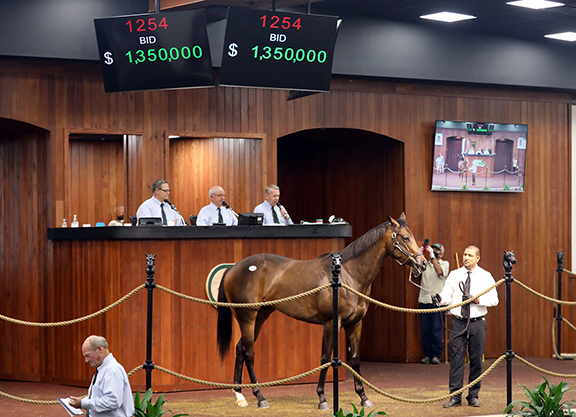By Chris McGrath
Last year, an ongoing bull run in the North American bloodstock market carried the juvenile sector to a historic breakthrough. For the first time, aggregate turnover broke the $200 million barrier. The momentum felt so giddy that the next milestone, with the mean cost of a 2-year-old standing at $95,807, promised to be a six-figure average.
No market, of course, can sustain perennial growth. Capitalism requires recession to regenerate value. While these cycles will ideally be mild, this particular market is always especially exposed to any incipient weakness. Very often, it trades in animals that have already had to generate a profit for two sets of speculators: a commercial breeder, and a weanling-to-yearling pinhooker. With the raw materials becoming ever more expensive, then, the stakes for this third group had been rising precariously. Their record gross last year had been fed by a yearling market, in 2018, averaging nearly 30% more than had been the case only two years before.
And then, out of nowhere, the whole apparatus of the global economy was broadsided by COVID-19.
If these are indeed unprecedented times, at least in the postwar era, then there's limited point in historic comparisons. But for what it's worth, when the hammer came down on Hip 1114 at OBS last week, business for North American juveniles in 2020 was completed at $125,956,800, a drop of $77,374,900 or 38%; with the average down 24% to $72,389.
But never mind “comparing apples and pears.” This is like being trying to make sense of eviction from the most fertile and succulent orchard of Calvados, to harvest a few twisted, diseased stumps in a city backyard instead. The panic infecting vendors in the spring, as the Wall Street elevator went into nauseous reverse, was such that most would probably settle for maintaining three-quarters of the 2019 average as a pretty tolerable outcome.
The pandemic hit just as consignors were bringing their horses to a peak. OBS tottered bravely through its March Sale, but Fasig-Tipton called off its glamorous auction at Gulfstream; and Keeneland followed suit with its April catalog. By the time the sales companies had regrouped–improvising a summer market, deep into a curtailed juvenile program on the racetrack–many pragmatists had already staunched the flow by private deals with trusted clients.
So the most fundamental barrier to any coherent year-on-year comparison is the unknown volume of business conducted away from the sales ring. There was a 6.9% drop in the animals that even made a catalog, from 3,924 to 3,652. But there was also a significant rise among those who were entered for a sale but then scratched.
Even during the runaway bull run, of course, trade was ruthlessly predicated on a) a fast time and b) passing the vet. In the last two years, this endemic risk aversion had maintained catalog withdrawals at almost precisely 30%. This time, scratchings amounted to 37.45%. The net decline in the public market, then, amounted to 16.6%: 2,284 entering the ring, down from 2,740.
Among those that did so, moreover, only limited consolation can be drawn from a clearance rate that superficially held up very well-just a fraction down, at 76.18%, on 77.4% last year. For one thing, stable demand in a reduced pool equates to reduced demand. But the goalposts had also been moved so far that many vendors felt obliged to write off a project altogether; to cut losses by taking whatever was on offer. Their priority will simply have been to ride out this juddering bump in the road, and salvage enough capital to turn the overall slump to their advantage when, lean and mean, they open the next pinhooking cycle at the yearling sales.
Only four stallions made a seven-figure sale, compared with eight last year. Two of these were established heavy hitters, Quality Road and Uncle Mo; whereas the other pair, Not This Time and Speightster, were making headlines with their first crop.
Unmistakably, Not This Time was the market's breakout achiever. He not only sold the most expensive 2-year-old of the year, a $1.35 million filly at the OBS “Spring” Sale, but maintained a $80,000 median and $175,216 average off a $15,000 opening fee.
As ever, stallions are grossly flattered by the exclusion of RNAs from their averages: rewarded, in effect, for failing to find a home for their weakest offerings. So a couple that deserve a mention for quiet, consistent merit this year are Flatter, who sold all but one of his 10 into the ring, for a $208,333 average and $170,000 median (crop foaled at $35,000); and Tapizar, who moved on six of seven at a $152,916 average and $100,000 median ($15,000 fee). Flatter's dividends were broadly on a par with those he registered with this crop as yearlings ($198,088 average, $140,000 median); but Tapizar's yearlings in 2019 traded at an average of $46,979 and a median of just $25,000.
That's pinhooking gold.
But stallion performance, overall, is another area plainly distorted by all those private sales. Last year, for instance, Into Mischief sent 56 juveniles into the ring; Uncle Mo, 40; and American Pharoah, 37. This time round, these commercial big guns were respectively represented by 35, 14 and 21. On that basis, it seems safe to assume that a lot of the cream was skimmed off the farms around Ocala.
It will, no doubt, be a long way home. As the bull run kept up its breathless tempo, we often cautioned how the therapies employed after the 2008 financial crisis had been greedily maintained beyond the recovery. If nobody could have planned for the form taken by the next shock, then everyone knew that the system was being wilfully exposed. Painkillers were now being prescribed as recreational drugs. Sure enough, governments everywhere now find themselves with no choice but to make huge and perilous surgical interventions.
Another point worth brief reiteration: the wider recovery after 2008 was slow to percolate into the bloodstock market. Having lost 33.8% in 2008, the Dow Jones rebounded 18.8% the following year. It was a similar story with GDP: the entire 2.5% loss of 2009 was restored the following year.
North American bloodstock, in contrast, made consecutive losses between 2008 and 2010 of 21.2, 32.2 and 6.5%; and had to wait until 2013 to get back on an even keel.
And it's hard to resist the sense that the environment, this time round, is much more hazardous. We've spent a decade pumping liquidity steroids into the global economy. The most affluent have had their gains topped up by tax breaks and deregulation. And, all round the world, these divisive economics have been “secured” by electoral populism. Those don't look terribly solid foundations for the massive reconstruction required ahead.
On the other hand, we have to keep the faith. The best harvests tend to be sown than when a field has been most thoroughly harrowed. Returning to this specific market, you have to feel sorry for anyone who launched a business in the 2019-20 yearling-juvenile cycle. But history tells us that each “bust” invariably contains the seeds of the next “boom.” For anyone with the resources, audacity and skill to play a long game, this is the perfect moment to go into business.
It's a more obviously propitious moment, of course, for those on the other side of the fence: the buyers. Trainers who have clung to viability will have picked up oven-ready runners at a bargain rate this spring. For bloodstock investors, equally, now is the time to find that stallion's page; that foundation mare. And not just because prices are down. One of the latent dynamics of recession is that the guys who come out the other side will tend to be those with a worthwhile product. It's the survival of the fittest. And those who have established their class through thick and thin, by reliably identifying and drawing out potential in a young Thoroughbred, won't complain if they lose a few competitors who have simply jumped into their slipstream, during the boom years, thinking that the game is easy.
Who knows? Perhaps this crisis can even become a cue for everyone to be a little more grown-up about the stopwatch. Remember that the sector has matured, first and foremost, through the consummate horsemanship of consignors–many of whom feel increasingly uncomfortable about the commercial imperative of the “bullet” breeze. They are under ever more pressure to light a dangerous fuse in an animal that will never run so fast again. So if we lose a few who simply train young horses to sprint for :10 seconds flat, maybe that would be no bad thing.
Presumably the yearling market is about to endure similar travails, if not worse. Whereas the juvenile sector measures the appetite for immediate action, the rest of the sales calendar opens more patient cycles. But “correction,” across the board, is not just about inflated values. Maybe vendors, forced to think about what their brand should represent in the longer term, might actually realize that their own interests–like those of the breed itself–are better served by horses that can run; and not just horses that can sell.
Not a subscriber? Click here to sign up for the daily PDF or alerts.






